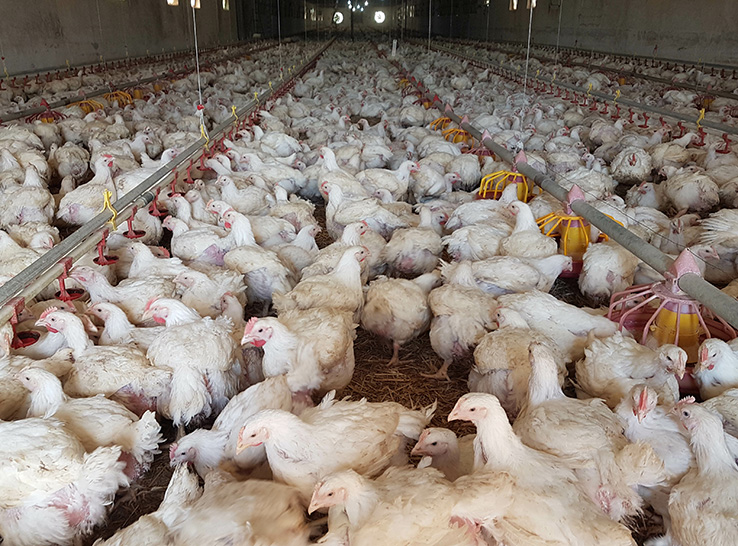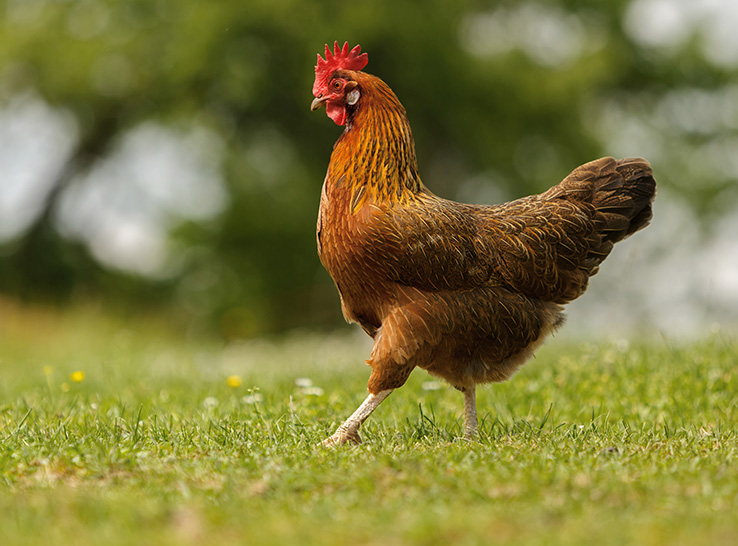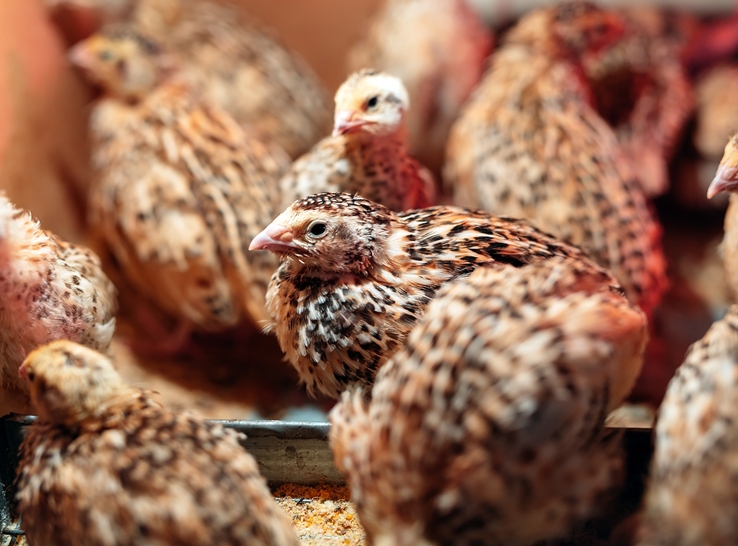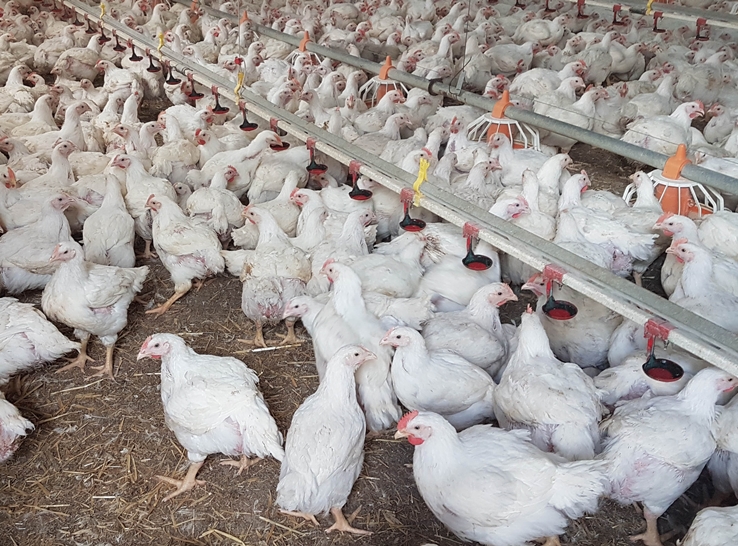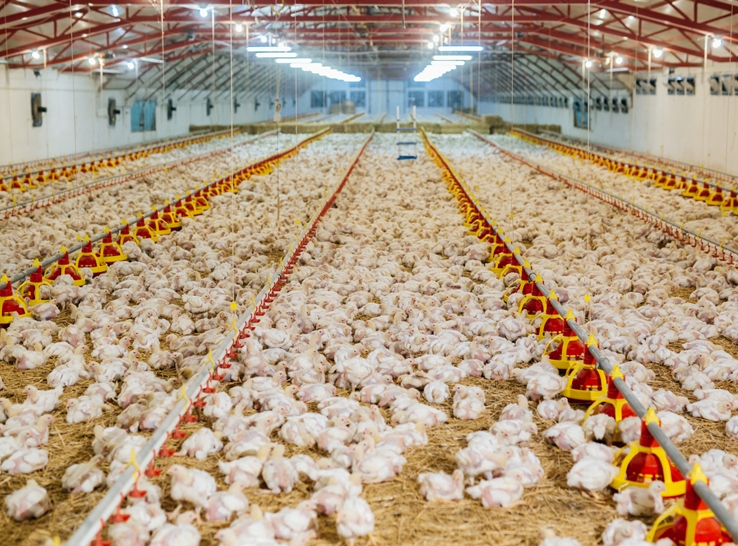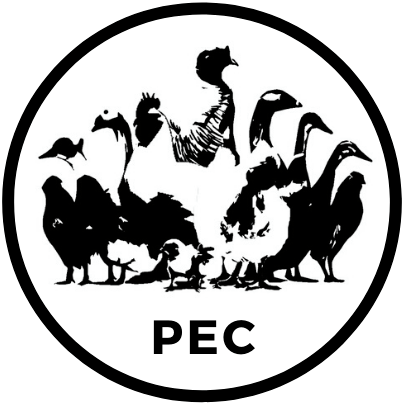By Dr. Allison Pullin, North Carolina State University
Currently, 34% of laying hens used for commercial egg production in the United States are housed in cage-free environments.1
This number will nearly double to 66% by 2026 by to meet retailer demands and state legislation requirements.1
In cage-free housing, multi-tiered aviary structures are often used, where key resources (i.e., feed, water, nests, perches) are available on elevated platforms called tiers, and litter substrate is available on the ground floor for dustbathing and foraging. Hens move vertically and horizontally across the elevated structures to access resources, which requires the hens to have skilled physical movements and cognitive abilities to process spatial information.
Before laying hens are moved into their adult laying environment, they are raised in a rearing environment as sexually immature pullets for the first 16 to 18 weeks of life. The types of experiences that rearing environments provide affect key aspects of bird development that can have consequences for laying hens in their adult environment.
This newsletter describes how spatial abilities develop during pullet rearing, how improper rearing can lead to adverse consequences in the laying environment, and how to improve acclimation to a multi-tiered aviary laying environment.
Pullet development: Spatial abilities
Spatial cognition!
When chicks hatch, the left hemisphere of their brain is dominant due to brain lateralization that happens during embryonic development. Chicks also have a fully developed visual system by 2 days of age.2,3 In combination, these neurological and visual characteristics allow chicks to focus on “local spatial cues” during the first 11 days of life, such as following moving objects and discriminating food resources. If a maternal hen was present, chicks would stay in closest proximity to her during this time. At 11 days of age, there is a shift in brain lateralization, such that the right hemisphere becomes dominant and birds become sensitive to developing spatial memory (e.g., location of important resources).4 After this hemispheric shift, birds can perceive “global spatial cues” in their environment, meaning they can process the bigger picture of their spatial environment (e.g., how do different structures relate to each other).
Behavioral experience!
Once they can process the bigger picture, we start to see more behavioral development of using structures in the environment, if the structures are provided. Most pullets start using perches by about 2 weeks of age and increasingly use elevated structures more and move up to higher places over time.5 The design of the perch (e.g., shape and material influencing grip and stability on the structure) and amount of height provided (e.g., the angles and distance birds practice using) would influence how this behavior develops.
Musculoskeletal system!
Also during this time, musculoskeletal development is happening. Structural bone formation occurs during the pullet rearing phase.6 There is improved development of structural bone if birds have access to exercise that requires them to move upward to elevated spaces early in life6, which is called load-bearing exercise as they move against gravity. Wing and breast muscles are also larger with load-bearing exercise as birds flap to ascend and descend from elevated structures.6
In summary, three key components that influence spatial abilities are developing and interacting during the rearing phase: spatial cognition, behavioral experience with elevated structures, and musculoskeletal strength.
Rearing affects laying
When pullets are NOT provided with opportunities to develop spatial abilities during rearing*, they do not successfully acclimate to spatially complex laying environments. The following outcomes have been reported in laying environments that contain elevated structures or in experimental tasks that require hens to access elevated structures:
- Reduced use of elevated structures7,8,9 More collisions with elevated structures9
- Less developed musculoskeletal system[6,10,11] Higher prevalence of keel bone fractures8,12 Higher risk of cloacal cannibalism13
- Higher risk of floor eggs (i.e., eggs laid outside of the nest)14 More fearfulness7
- Worse performance on a spatial memory task15
Improving acclimation to aviaries
In order to improve hen performance and welfare in cage-free aviaries, it is crucial to prepare birds and facilitate their acclimation to these environments. Key tips to ensure a smooth acclimation include:
Pullet rearing!
Design pullet rearing environments to promote the development of spatial abilities that will be similar to what birds will encounter in the lay house (e.g., rear pullets in multi-tiered aviaries, provide pullets with access to elevated structures as early as possible, promote use of elevated structures by providing ramps during rearing).
Layer training!
Walk the layer flock several times each day for at least the first two weeks in the new environment to promote movement in and out of the system. When lights go off at night, move any birds found on the litter floor up onto the aviary tiers to promote roosting in the aviary. The first two weeks in the layer housing are critical, but training is recommended through peak egg production.
Layer aviary design!
Add ramps to the layer environment to assist movement in and out of the multi-tiered aviary. Ramps allow birds to walk up to different heights if their physical and/or cognitive skills make jumping between structures difficult.
Summary
- During pullet rearing (the first 16 to 18 weeks of life), birds are sensitive to cognitive, behavioral, and musculoskeletal development that affects how they use elevated structures (i.e., spatial abilities).
- When pullets are not provided with elevated space early in life, but then expected to move up and down from structures as adults, negative consequences are reported for behavior, injuries, and egg laying.
- These consequences can be avoided, or at least mitigated, with rearing environments that match the laying environment, training laying hens after they are transferred, and modifying the design of the layer environment.
Resources
- United Egg 2023. Facts & stats: Housing environments of U.S. laying hens. <https://unitedegg.com/facts-stats/>. Accessed Sept 22, 2023.
- Over, A. Y., and D. Moore. 1981. Spatial acuity of the chicken. Brain Res. 211:424–426.
- Schmid, L., and C. F. Wildsoet. 1998. Assessment of visual acuity and contrast sensitivity in the chick using an optokinetic nystagmus paradigm. Vision Res. 38:2629–2634.
- Freire, R., H. W. Cheng, and C. J. Nicol. 2004. Development of spatial memory in occlusion- experienced domestic chicks. Anim. Behav. 67:141–150.
- Habinski, A. M., L. J. Caston, M. E. Hunniford, and T. M. Widowski. 2017. Development of perching behavior in 3 strains of pullets reared in furnished cages. Poult. Sci. 96:519–529.
- Casey-Trott, M., D. R. Korver, M. T. Guerin, V. Sandilands, S. Torrey, and T. M. Widowski. 2017. Opportunities for exercise during pullet rearing, Part I: Effect on the musculoskeletal characteristics of pullets. Poult. Sci. 96:2509–2517.
- Brantsæter, M., J. Nordgreen, T. B. Rodenburg, F. M. Tahamtani, A. Popova, and A. M. Janczak. 2016. Exposure to increased environmental complexity during rearing reduces fearfulness and increases use of three-dimensional space in laying hens (Gallus gallus domesticus). Front. Vet. Sci. 3:14.
- Norman, K. I., C. A. Weeks, J. F. Tarlton, and C. J. Nicol. 2021. Rearing experience with ramps improves specific learning and behaviour and welfare on a commercial laying farm. Sci. Rep. 11:8860.
- Pullin, A. N., S. M. Temple, D. C. Bennett, C. B. Rufener, R. A. Blatchford, and M. M. Makagon. 2020. Pullet rearing affects collisions and perch use in enriched colony cage layer housing. Animals 10:1269.
- Regmi, , T. S. Deland, J. P. Steibel, C. I. Robison, R. C. Haut, M. W. Orth, and D. M. Karcher. 2015. Effect of rearing environment on bone growth of pullets. Poult. Sci. 94:502–511.
- Hester, Y. 2014. The effect of perches installed in cages on laying hens. Worlds. Poult. Sci. J. 70:247–264.
- Casey-Trott, T. M., M. T. Guerin, V. Sandilands, S. Torrey, and T. M. Widowski. 2017. Rearing system affects prevalence of keel-bone damage in laying hens: A longitudinal study of four consecutive Poult. Sci. 96:2029–2039.
- Gunnarsson, S., L. J. Keeling, and J. Svedberg. 1999. Effect of rearing factors on the prevalence of floor eggs, cloacal cannibalism and feather pecking in commercial flocks of loose housed laying hens. Br. Poult. Sci. 40:12–18.
- Tauson, R. 2005. Management and housing systems for layers: Effects on welfare and production. Proc. Nutr. Soc. 61:477–490.
- Tahamtani, F. M., J. Nordgreen, R. E. Nordquist, and A. M. Janczak. 2015. Early life in a barren environment adversely affects spatial cognition in laying hens (Gallus gallus domesticus). Front. Vet. Sci. 2:3.
To view the full Poultry Extension Collaborative newsletter, Vol 43, click here.
Editor’s note: Content on Modern Poultry’s Industry Insights pages is provided and/or commissioned by our sponsors, who assume full responsibility for its accuracy and compliance.
*Results are for pullets that were not given access to perches, ramps to facilitate access to elevated structures, or were not reared in aviaries compared to pullets who were reared with those components in their environment.

